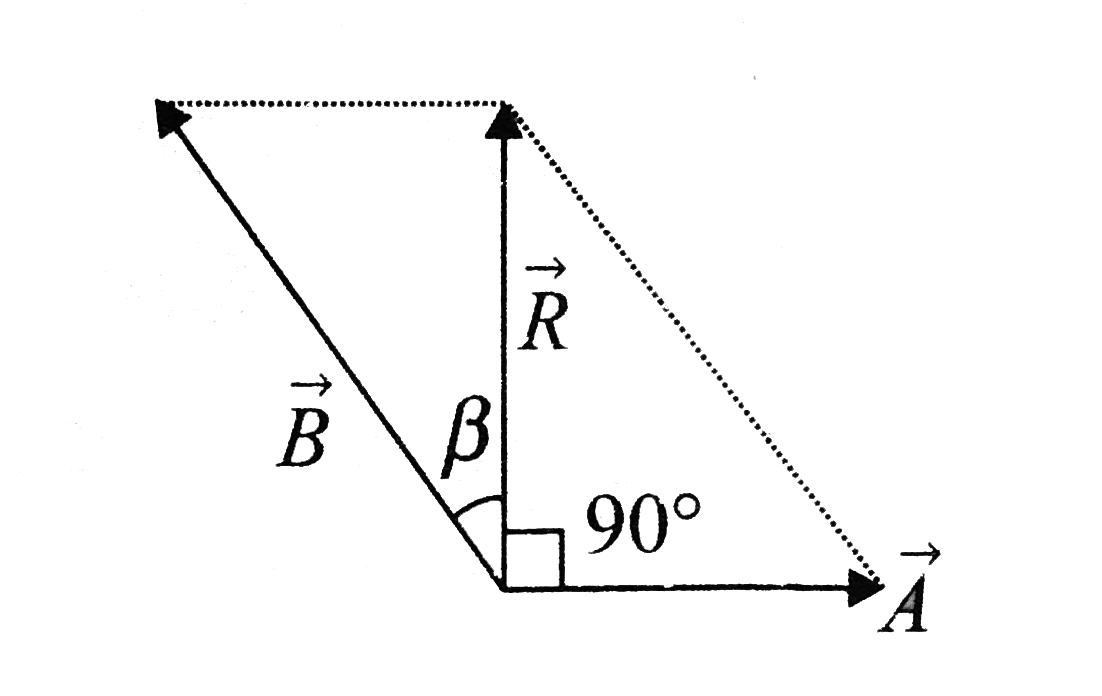Two vectors →A and →B have equal magnitudes . If magnitude of →A+→B is equal to n× the magnitude of →A−→B , then the angle between →A and →B is
cos−1[n2−1n2+1]
cos−1[n−1n+1]
sin−1[n2−1n2+1]
sin−1[n−1n+1]
To solve the problem, we need to find the angle between two vectors →A and →B given that they have equal magnitudes and that the magnitude of →A+→B is equal to n times the magnitude of →A−→B.
1. Define the Magnitudes:
Let the magnitudes of both vectors →A and →B be x. Therefore, we have:
|→A|=|→B|=x
2. Express the Magnitudes of the Sum and Difference:
The magnitude of the sum of the vectors is given by:
|→A+→B|=√|→A|2+|→B|2+2|→A||→B|cosθ=√x2+x2+2x2cosθ=√2x2(1+cosθ)
The magnitude of the difference of the vectors is given by:
|→A−→B|=√|→A|2+|→B|2−2|→A||→B|cosθ=√x2+x2−2x2cosθ=√2x2(1−cosθ)
3. Set Up the Given Condition:
According to the problem, we have:
|→A+→B|=n⋅|→A−→B|
Substituting the expressions we derived:
√2x2(1+cosθ)=n⋅√2x2(1−cosθ)
4. Square Both Sides:
Squaring both sides to eliminate the square roots gives:
2x2(1+cosθ)=n2⋅2x2(1−cosθ)
We can cancel 2x2 from both sides (assuming x≠0):
1+cosθ=n2(1−cosθ)
5. Rearranging the Equation:
Rearranging the equation gives:
1+cosθ=n2−n2cosθ
Bringing all terms involving cosθ to one side:
cosθ+n2cosθ=n2−1
(1+n2)cosθ=n2−1
6. Solve for cosθ:
Thus, we find:
cosθ=n2−11+n2
7. Find the Angle θ:
Finally, to find the angle θ:
θ=cos−1(n2−11+n2)
Final Answer:
The angle between the vectors →A and →B is:
θ=cos−1(n2−11+n2)
Let the magnitudes of both vectors →A and →B be x. Therefore, we have:
|→A|=|→B|=x
The magnitude of the sum of the vectors is given by:
|→A+→B|=√|→A|2+|→B|2+2|→A||→B|cosθ=√x2+x2+2x2cosθ=√2x2(1+cosθ)
The magnitude of the difference of the vectors is given by:
|→A−→B|=√|→A|2+|→B|2−2|→A||→B|cosθ=√x2+x2−2x2cosθ=√2x2(1−cosθ)
According to the problem, we have:
|→A+→B|=n⋅|→A−→B|
Substituting the expressions we derived:
√2x2(1+cosθ)=n⋅√2x2(1−cosθ)
Squaring both sides to eliminate the square roots gives:
2x2(1+cosθ)=n2⋅2x2(1−cosθ)
We can cancel 2x2 from both sides (assuming x≠0):
1+cosθ=n2(1−cosθ)
Rearranging the equation gives:
1+cosθ=n2−n2cosθ
Bringing all terms involving cosθ to one side:
cosθ+n2cosθ=n2−1
(1+n2)cosθ=n2−1
Thus, we find:
cosθ=n2−11+n2
Finally, to find the angle θ:
θ=cos−1(n2−11+n2)
The angle between the vectors →A and →B is:
θ=cos−1(n2−11+n2)
Topper's Solved these Questions
Similar Questions
The resultant of two vectors →A and →B is perpendicular to the vector →A and its magnitudes is equal to half of the magnitudes of vector →B (figure). The angle between →A and →B is

View SolutionWhat is the condition for magnitude of →A+→B to be equal to that of →A−→B ?
View SolutionIf →A=→B+→C, and the magnitudes of →A,→B,→C are 5,4, and 3 units, then the angle between →A and →C is
View SolutionThe magnitude of vector →A,→B and →C are respectively 12,5 and 13 unit and →A+→B=→C then the angle between →A and →B is
View SolutionThe magnitudes of vectors →A,→Band→C are 3,4 and 5 unit respectively. If →A+→B=→C, the angle between →Aand→B is
View SolutionTwo vectors →A and →B are such that ∣∣→A+→B∣∣=∣∣→A−→B∣∣ then what is the angle between →Aand →B :-
View SolutionIf →a and →b are two vectors such that ∣∣→a×→b∣∣=→a.→b, then what is the angle between →a and →b.
View SolutionIf |→a|+∣∣→b∣∣=|→c|and→a+→b=→c, then find the angle between →aand→b.
View SolutionTwo vectors →a and →b are such that ∣∣→a+→b∣∣=∣∣→a−→b∣∣. What is the angle between →a and →b?
View SolutionIf →aand→b are two vectors of magnitude 1 inclined at 1200 , then find the angle between →band→b−→a.
View Solution
